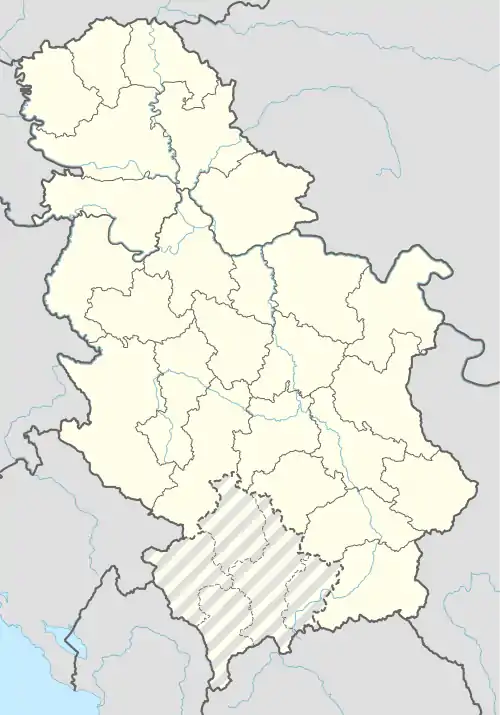Lovćenac
Lovćenac (Serbian Cyrillic: Ловћенац) is a village located in the Mali Iđoš municipality, in the North Bačka District of Vojvodina, Serbia. The village is known as the de facto capital of ethnic Montenegrins in Serbia, and has a total population of 3,161 people (2011 census).
Lovćenac
| |
|---|---|
 Intersection in Lovćenac | |
 Lovćenac | |
| Coordinates: 45°41′N 19°41′E | |
| Country | |
| Province | |
| District | North Bačka |
| Founded | 1476 |
| Government | |
| • Type | Council |
| • President | Tatjana Roganović |
| Area | |
| • Total | 38.3 km2 (14.8 sq mi) |
| Elevation | 89 m (292 ft) |
| Population (2011) | |
| • Total | 3,161 |
| • Density | 83/km2 (210/sq mi) |
| Time zone | UTC+1 (CET) |
| • Summer (DST) | UTC+2 (CEST) |

Name
In Serbian, the village is known as Lovćenac (Ловћенац), in German as Sekitsch (in the past rarely Winkelsberg), and in Hungarian as Szeghegy.
Its former name in Serbian was Sekić (Секић). After the World War II, the village was named Lovćenac by the Montenegrin settlers after Mount Lovćen in Montenegro.
The original Hungarian name of the village was Szeghegy, but Hungarians also used Serbian version of the name in the forms Szikics and Szekics, as well as Germans in the form Sekitsch. One very rare alternative German name was Winkelsberg.
History
The village first appeared in history in 1476. During the Ottoman administration, the village of Sekić was populated by ethnic Serbs.[1] The ethnic Germans settled there in 1786. These German settlers, originally from all over, came to be a distinct group known as Vojvodina Germans (Wojwodinedeutsche), a branch of the Danube Swabians since 1918. At its peak (in 1910), the village had a population of 5,394 people,[2] mostly Germans.[3] Following the Axis occupation of this part of Yugoslavia (1941-1944) and end of World War II, most of the Germans left the country, together with the defeated German army. Those who remained were interned into prison camps. After camps were disbanded in 1948, most of the remaining Yugoslav Germans emigrated to Germany because of economic reasons in the next decades. After World War II, the village was colonized by settlers from Montenegro and Mt. Vlašić, Bosnia. The Montenegrins renamed the village in honor of Mt. Lovćen and account for the majority of the population.[4][5][6]
Demographics
Ethnic Groups
Ethnic composition of Lovćenac inhabitants according to the 2002 Republic of Serbia census. Village population 3,693
Historical population
- 1885: 4,134
- 1900: 4,936
- 1910: 5,394
- 1945: 4,447
- 1948: 4,791
- 1961: 4,800
- 1971: 4,159
- 1981: 4,016
- 1991: 4,049
- 2002: 3,693
- 2011: 3,161
Culture
The society of Montenegrins in Serbia known as Krstaš is based in Lovćenac.
Notable people
- Mitar Pešikan, Linguist and member of the Serbian Academy of Sciences and Arts
- Sofija Pekić, former female Serbian basketball player, Olympic bronze medalist
- Danilo Popivoda, former Slovenian football player of Serbian descents
- Nenad Stevović, Politician
See also
- Montenegrins of Serbia
- List of places in Serbia
- List of cities, towns and villages in Vojvodina
Notes
- Dr Dušan J. Popović, Srbi u Vojvodini, knjiga 1, Novi Sad, 1990, page 113.
- Slobodan Ćurčić, Broj stanovnika Vojvodine, Novi Sad, 1996, page 122.
- "Archived copy". Archived from the original on 2011-10-07. Retrieved 2011-06-28.CS1 maint: archived copy as title (link)
- "Влашић - Ловћенац". Влашић - Ловћенац (in Serbian). Retrieved 2020-06-30.
- Welle (www.dw.com), Deutsche. "Vojvođanski Crnogorci u grotlu prisajedinjenja | DW | 23.11.2018". DW.COM (in Serbian). Retrieved 2020-06-30.
- "Crnogorci u Srbiji nijesu tuđinci". CdM. 2019-07-13. Retrieved 2020-06-30.
References
- Slobodan Ćurčić, Broj stanovnika Vojvodine, Novi Sad, 1996.
Gallery
 An intersection on the main road in Lovćenac today.
An intersection on the main road in Lovćenac today. Memorial for soldiers from Lovćenac who died in World War I.
Memorial for soldiers from Lovćenac who died in World War I. This memorial, referred to as "de Steen", was erected in 1895 to commemorate those who died in a 1849 battle near Lovćenac.
This memorial, referred to as "de Steen", was erected in 1895 to commemorate those who died in a 1849 battle near Lovćenac.
 Sekić got its first post office in 1872.
Sekić got its first post office in 1872.
External links
| Wikimedia Commons has media related to Lovćenac. |
- Krstaš
- Mi smo Crnogorci, sa azbukom od 33 slova, Glas javnosti, 5 February 2006 (about Montenegrins of the village)
